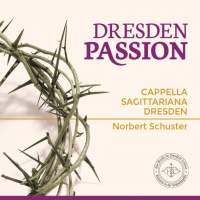Texte paru dans: / Appeared in: |
|
|
Outil de traduction ~ (Très approximatif) |
|
|
Reviewer: J.
F. Weber Four CD packages arrived four weeks after Easter, all of them containing sacred music for the Passion. They must have been issued at home appropriately during Lent, so Fanfare’s publication schedule is not entirely responsible for the appearance of these reviews during the summer. This set is the most unusual of the four, two skimpy discs described as Protestant Passion music at the Dresden court. The title might better focus on the principal content of the program, the first recording of a St. Mark Passion attributed to Schütz as early as 1692, when the earliest surviving copy of this and his three authentic Passions was made. Actually composed by Marco Giuseppe Peranda (1625–1675) and performed in Dresden in 1668, it was even published in 1886 in the Complete Works of Schütz edited by Spitta, and only in 1969 did Wolfram Steude establish Peranda’s title to the work. Peranda appeared in Fanfare 39:6 for only the second time in connection with Bach. One of many Italian musicians who appeared at the Dresden court in the 1650s, he is said to have become vice Kapellmeister in 1661 (Schütz was in semi-retirement after the accession of the Elector Johann Georg II in 1656) and Kapellmeister in 1663, though it is also stated that he succeeded Schütz in this position upon his death in 1672, serving until an early death less than three years after Schütz. The Passion is broken into sections by the insertion of seven symphonias from Schütz’s Die sieben Worte, five brief Konzerte and other sacred works, and similar works by Peranda himself and four other composers. These include a Sieben Wort [sic] by Johann Schein that covers the subject in less than four minutes. The great Tenebrae responsory Tenebrae factae sunt, somewhat out of place here, is added early on with a performance that matches Dom Jean Claire’s Solesmes version perfectly. As the notes put it, these additions transform Peranda’s 17th-century chorale Passion into an 18th-century oratorio Passion such as Bach’s. They also turn what would have been a skimpy single disc of less than 45 minutes into two skimpy discs. Yet this is what Schuster gives us for the first recording of a work that was attributed to Schütz for centuries. Schuster also accounted for the first appearance of Peranda in Fanfare 35:5 on a disc that illustrated the life of Schütz by selections from his and other’s works. I called that recording brilliant in its conception and its execution a triumph. It is worth noting that just a few years before Steude identified the composer of this Passion, Hans Joachim Moser, the leading authority on Schütz, rejected his authorship but erroneously called it “obviously the work of a somewhat earlier period.” Now that we can hear it, obviously a work that looks forward to a later period, we can sort out the reasons for the conflicting notions of authorship that preceded Steude’s breakthrough. One might even try using the table of contents and your remote control to skip through, hearing only the Passion tracks, to get a better idea of what it might have sounded like on Good Friday in 1668. This is a real contribution to 17th-century sacred music on records. | |
|
|
|
|
Cliquez l'un ou l'autre
bouton pour découvrir bien d'autres critiques de CD |
|




